Robin Murphy's Blog, page 3
December 31, 2018
Subplots - The Meat & Potatoes To Your Main Plot
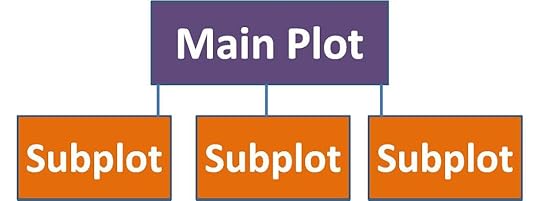
 Subplots can add interest and complications to your main plot. They're the smaller conflicts that diverge from the main plot for a while, and then return to be completed within the resolution of the larger main plot. If you're writing a series, some minor subplots may be resolved in later books.
Subplots can add interest and complications to your main plot. They're the smaller conflicts that diverge from the main plot for a while, and then return to be completed within the resolution of the larger main plot. If you're writing a series, some minor subplots may be resolved in later books.Subplots allow your readers to learn more about secondary character relationships without the pressures of the main plot's demands. You'll be able to take your readers to places the main plot won't visit. They'll provide new information, conflicts, and complications to enhance your main plot. Characters—main and strong secondary characters—are your best sources for effective subplots.
Giving your main character more than one conflict to confront adds more dimension to the story and keep the reader wanting to learn more. Say your character gets involved in a murder, that's the main plot. But he's also involved with a woman and can't get over his first wife's death. Since the murder is the main plot, the developing romance becomes a strong subplot.
Another subplot could be your main character being connected to a neighborhood kid who is following in the footsteps of his older brother into gang life. Maybe your main character tries to help this kid stay on the straight and narrow path. This relationship could offer insights into your main character's childhood. Giving the reader knowledge that the main character has flaws is a compelling hook.
Subplots can provide inside information, which can create suspense. They can also reveal a villain's motivations or explain a character's confusing actions. Subplots can also reveal a backstory. They offer a great opportunity for readers to spend time with interesting secondary characters.
Be careful not to have too many subplots. Once a subplot holds the reader's attention as strongly as the main plot, it's no longer a subplot. You can have a main plot disappear for a while, but be careful not to lose your reader from your main plot. If you find yourself spending more time and energy on a subplot than on the main plot, you may want to step back and reconsider your story plot. Maybe your subplot should be your main plot.
You can begin a subplot anywhere that seems appropriate. If two characters meet a third of the way into your story and their relationship drives the subplot, that's where you should begin it. If it's going to be part of the story from beginning to end, introduce it early in your novel, possibly within the first three or four chapters. Just be sure to make sense of your story's dramatic arc.
Make sure you don't choke on the ending of your subplot. Be careful not to pack all the resolutions to your subplots in the final chapter. Your readers can feel overwhelmed by an avalanche of small endings. You can resolve subplots before or after the climax and the main plot resolution. You may try resolving a subplot during the climax scene, as long as it doesn't weaken the tension of your peak scene.
And finally, please don't leave any loose ends. Be sure your subplot ties to the main plot, or it will distract from it. Obviously, if your subplot involves your main character, it's automatically tied into the main plot. Don't lead your readers astray on a minor character's actions in a subplot. They'll end up enjoying the subplot more than the main plot and weakened your story. If your subplot deepens the characterization of our main character, that's probably enough.
I hope this helps you create a meat and potatoes type of subplot while enhancing your story and keeping your reader hooked to the very end.
Remember, keep on writing...
Published on December 31, 2018 04:00
December 24, 2018
Interview With Award Winning Author, Doug Lamoreux, About His Latest Novel, Saucy Jacky
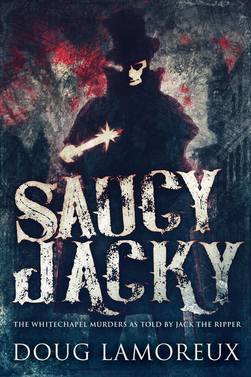 [image error]
[image error] 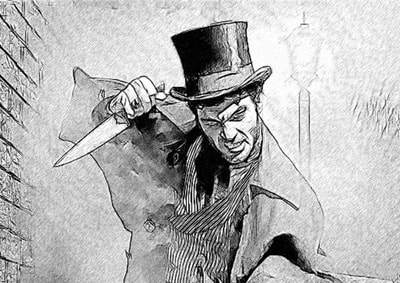 Hello everyone, and welcome to another fantastic interview with Doug Lamoreux. He is the last, quite possibly the least, Renaissance man, a father of three strong men and a grandfather, a lifelong horror film fan and child of Famous Monsters of Filmland magazine, recognized his incompatibility with the rest of the world - and gave it all up to act and write. He appeared in Mark Anthony Vadik's The Thirsting (aka Lilith) and Hag. He starred in Peter O'Keefe's Infidel and Boris Wexler's The Arab. All interspersed with forty years in theater (during which he fell off the stage twice). Now he writes swell horror novels. The first-ever Igor Award recipient from The Horror Society, Doug is a former Pushcart Prize nominee, Rondo Award nominee, and his novel, Dracula's Demeter, was a 2012 Lord Ruthven Award nominee for fiction.
Hello everyone, and welcome to another fantastic interview with Doug Lamoreux. He is the last, quite possibly the least, Renaissance man, a father of three strong men and a grandfather, a lifelong horror film fan and child of Famous Monsters of Filmland magazine, recognized his incompatibility with the rest of the world - and gave it all up to act and write. He appeared in Mark Anthony Vadik's The Thirsting (aka Lilith) and Hag. He starred in Peter O'Keefe's Infidel and Boris Wexler's The Arab. All interspersed with forty years in theater (during which he fell off the stage twice). Now he writes swell horror novels. The first-ever Igor Award recipient from The Horror Society, Doug is a former Pushcart Prize nominee, Rondo Award nominee, and his novel, Dracula's Demeter, was a 2012 Lord Ruthven Award nominee for fiction.Sit back and relax, grab a cup of coffee, and enjoy the story behind Saucy Jacky, the Whitechapel Murders As Told By Jack the Ripper, and what it took to get it on paper.
Synopsis of Saucy Jacky:
London, 1888. Walk side by side through the streets of Whitechapel with history's most notorious killer. Listen, or try not to, to his thoughts as he lurks in the shadows. Keep pace, if you have the nerve, as he stalks his victims. Watch, if you have the stomach, as he commits his outrages. Run with him, if you can, as he escapes the swarming police desperate for his hide. In this unabashed novel of terror, award-winning author Doug Lamoreux invites you to imagine the unimaginable. ‘Saucy Jacky’ The Whitechapel murders... as told by Jack the Ripper.
How did you come up with the premise for your latest book, Saucy Jacky?
I’m a history buff and, like many, have always had a fascination for that hideous moment in history. There are hundreds of ‘Ripper’ books that address the investigation into his crimes, the details of his victims’ lives and, most especially, countless studied guesses as to his identity. But, as an author of horror fiction, I wasn’t interested in who he was. I wanted to address what he was. What kind of monster was this man? That meant experiencing the summer and autumn of 1888 inside the mind of the Whitechapel killer. I played with the idea, without ever writing a word, for years, but knew I needed to learn how to write before I attempted it. Nine published novels later… Saucy Jacky was ready to ‘come out and play’.
We all know how much research goes into writing a story, but what particular types of research did you do for this amazing read?
The need was to take the reader into Victorian England. Obviously I had to live and breathe that setting first. That was no hardship. I have always been a huge reader of 19th century authors (Collins, Dickens, Stevenson, Stoker) and modern writers using that period (Anne Perry, Caleb Carr) I’ve read Doyle’s Holmes canon. I am an addict for everything Hammer Films (particularly their Victorian horrors). I am a history junkie (I’d already done an enormous amount of research for my earlier ‘Dracula’s Demeter’).
I had to research the Ripper murders in and out. I didn’t want the romantic fog-shrouded London of the movies. I wanted the slums of the East End. I’d already read (and re-read) Sugden’s ‘The Complete History of Jack the Ripper’, Rumbelow’s ‘The Complete Jack the Ripper’, and others. I read them again. I chased forensic information on the internet. I read many newspaper excerpts (despite the vast amount of false information published at the time of the murders) as these would have been Jack the Ripper’s primary sources of information on the murder investigations. (I had to carefully consider the information available today that would NOT have been available to the killer.) I lived for five months with a map of 1888 London at my elbow. It was important to know the streets as well as the killer and the coppers to plot Jacky’s movements. Credible witnesses who saw the Whitechapel murderer, once I turned the perspective, became the characters Jacky saw as he moved through the streets. Wandering Whitechapel helped me find Jacky’s point of view.
I’m a huge anglophile, so it fascinated me to read the dialogue, as well as the storyline taking place in England in the 19th century. How were you able to so accurately bring that into this story?
That’s the trick, isn’t it? To bring something to life on paper; to transport the reader. I’m pleased you feel I pulled it off. The writer never knows until the reader says, “Yeah, I bought it.” The most important point about the dialogue is… that it isn’t real. Real speech is dull and rambling. Dialogue, accents, diction, should be character choices to propel the story. I didn’t want real people, I wanted interesting characters that ‘felt’ real and advanced the narrative. With accents, less is always more. Short phrases, snippets of accent (with comparable actions and emotions) best get the point across. Call someone a ‘fishmonger’ and the reader already draws a picture. You needn’t add much in the way of dialogue. More than a little is too much. And characters’ thoughts are as vital as dialogue. When Jacky makes himself up as an Irishman, he gets ‘lost in the part’ and his thoughts are as Irish as his accent. He looks at his reflection and thinks: ‘…wearing me new look, the eejits would stay dog wide of me.’ He’s Irish without saying a word. Give the reader a crumb, they’ll taste the whole pie.
You were able to describe the process of the killings. How did you bring the historical accuracy into those details? (i.e. blade, location of the wounds, victims names, etc.)
Murder may be a private affair, but the results are entirely public. In the case of Jack the Ripper, details of some autopsies, transcripts of Coroner’s Inquests, newspaper reports of the day, and various police memoirs, survive (in whole or in part) in many forms. I had the great fortune of following 130 years of ‘Ripperologists’ unearthing those facts.
I approached those facts from the opposite direction; with my thoughts, my background and education; ten years hospital work, ten years firefighting, EMT training; attendance at murder scenes, suicides, autopsies. Then, as I assume all writers do, I asked myself questions. The victim had that wound. How would that wound be inflicted? With what weapon? With what force? In what order did injuries occur? The first drafts of the ‘murder’ scenes were dull and clinical; terrible prose. Not prose at all, autopsy notes reversed and told in stilted first person, past tense: ‘I made an incision in her throat running from beneath the left ear to beneath the right ear.’ or ‘I dissected the lower descending aorta and cut through the pericardium.’ Just dreadful clinical nuts and bolts, but necessary to alter the perspective. There are hundreds of ‘Ripper’ books, thousands of serial killer books, but the majority approach the subject with sane historical ‘here’s what was found’. I came at it from the other way, from the killer’s point of view ‘here’s what I did and what I left’. Once the murders were mapped out, I rewrote in repeated passes to remove the antiseptic tone and give the prose harrowing life; to add Jacky’s personality.
As to the names, in a number of cases it took days, even weeks, for the authorities to identify the victims. Jacky could not have known their names and (certainly at first) didn’t care. He was cleaning the streets of drunk perverts. What did their names matter? For his ease and pleasure, Jacky gave them nicknames.
Let’s not deny the fact that, obviously, Jack the Ripper was a bit mad. What was it like being inside his head? What was it like to develop Jack the Ripper’s personality?
A bit mad? He was bat crap crazy! Whoever or whatever he was. During the murder sequences, it was obviously (and not surprisingly) dark. And terribly messed up. Jacky thought he was doing good work. He did not consider himself a villain. He had a dark and awful past, which he alludes to without going into, and that past has certainly led to his mania. But he does not see himself as a criminal. He sees his victims as criminals. He considers himself a ‘societal necessity’. Between murders, he’s an intelligent and well-read man (with his own prejudices and politics) growing more and more paranoid about events in the city around him. It was difficult to maintain that perspective for long stretches. I had to get up and go for walks in the sun every few hours. Oddly, I found Jacky also had a sense of humor. Twisted, admittedly, but a sense of humor just the same. In the long run, while it was dark, the process was also freeing. I did not have to bother with the rules of writing. No thought was too weird or awful in the first draft. Only in the end, when my role switched from writer to editor, did I have to govern the content.
I know what it takes to carry a scene. You did it seamlessly. What is your process of creating dynamic arcs to the story and carrying the reader into the next scene?
I lay out the elements of my plot and then, fearfully and fully aware I’m screwing it up, shuffle those events into what feels like their ‘arc’ positions. The chapter breaks (to a novelist) are like the commercial breaks to a television writer. The reader will likely pause, so build to a climax, build to a climax, build to a climax. You want them to come back to the story. David Gerrold refers to writers as crib babies, banging to a climax every 5-10 pages.
The story need not be offered chronologically. Tell it your way. Historical facts, or stumbled upon coincidences, make great hooks if you can spot and incorporate them. An example: Fact, Jacky’s second victim (Polly Nichols in Buck’s Row) was driven to the cemetery in a hearse provided free by a Hanbury Street mortician. Fact, coincidentally, Jacky’s third victim was killed in Hanbury Street. I used those separate facts as inspiration and result. I let the first enrage Jacky so much he chose Hanbury Street for his next crime to teach the undertakers a lesson. It made a nice chapter climax, moved the story to the next murder, and added to Jacky’s personality. In like fashion, I used a historically accurate dock fire as inspiration for one of his crimes.
I also created a series of characters, a landlady, a news seller, a nurse, to (unknowingly) provide Jacky (and the reader) with information he would need but would not otherwise have been privy to on his own. Many of their revelations made great chapter climaxes.
Where did you find the newspaper articles written about Saucy Jacky?
Books. Internet. All are well-researched and archived. Ripperology is its own science.
Why do you think Jack the Ripper was so obsessed with prostitutes? Or should I say, his disgust for them?
I haven’t the slightest idea. I don’t know who Jack the Ripper was. My fictional ‘Saucy Jacky’ hates the combination of alcohol and promiscuity. He only kills drunk (or just-sobering) prostitutes.
Finally, we asked the how, but why did you choose to write this story?
I was six months (and three hundred pages) into writing a tenth novel, when that project was suddenly halted and the draft shelved. It was a great story, and a great waste of my time and energy. I was angry, but the situation was not to be helped. I turned to three other (good) ideas, and played with each, but my black mood kept me from making any headway. I was a-sea as a writer and had some serious aggression needed relief. I put the other stories away and, finally, began scribbling notes on Jack the Ripper. Amazingly, mad as I was, Jacky began to write itself. Soon my anger became excitement, my mood changed, and I was up every morning at 1:00 a.m. writing. I was suddenly confident again. I’d stumbled into the rage necessary to bring Jack the Ripper to life. Saucy Jacky became my tenth novel.
What do you hope readers will take away from Saucy Jacky?
The same thing I want them to take from any of my works. I’d like them to experience something new about the human – sometimes inhuman – condition. I want them to be spooked, on edge (from the safety of their favorite reading chair), even amused; but moved in one way or another. If they are outraged, that’s okay too. Jack the Ripper was outrageous. Ultimately, I’d just like them to be entertained.
Thank you for doing the interview. I appreciate your time.
Thank you for asking. Merry Christmas and Happy New Year.
Purchase Saucy Jacky HERE
Find all of Doug's books HERE
Please feel free to ask Doug any questions you may have in the comments below. I'm sure he'd love to hear from you.
Published on December 24, 2018 04:00
December 17, 2018
The 16 Best Christmas Books to Read This Holiday Season According to TIME
 If you're looking for something to get you in the mood for Christmas, why not pick up a timeless Christmas story that will be sure to lift your spirits. TIME shares their 16 Best Christmas books that range from the usual, A Christmas Carol to poetry by Maya Angelou, for both adults and kids alike.
If you're looking for something to get you in the mood for Christmas, why not pick up a timeless Christmas story that will be sure to lift your spirits. TIME shares their 16 Best Christmas books that range from the usual, A Christmas Carol to poetry by Maya Angelou, for both adults and kids alike.Read their list HERE!
For you writers, A Complete How To Guide for Rookie Writers ebook is on sale for $1.99 from $5.99 until December 21st. Get it in time to learn how to publish your book in 2019! [image error] Rookie Writers Solutions would like to wish you and yours a Very Merry Christmas and a Happy New Year! Remember...Keep on Writing!
Published on December 17, 2018 04:00
December 10, 2018
How To Get Your Very Own Library of Congress Number
Below are step-by-step instructions to help you create your own Library of Congress number: [image error] [image error] 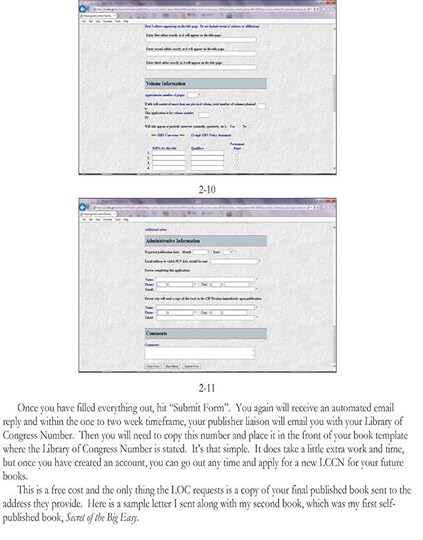 Robin Murphy
Robin Murphy
Address
Sharpsburg, MD 21782
www.rookiewriterssolutions.com
robin@rookiewriterssolutions.com Date
Library of Congress
US & Publisher Liaison Division
Cataloging in Publication Program
101 Independence Avenue, S.E.
Washington, DC 20540-4283
RE: Library of Congress Control Number: ####### (your given number)
To Whom It May Concern:
Please find enclosed the requested complimentary copy of Secret of the Big Easy.
Regards,
Robin Murphy
Author/Publisher
 Robin Murphy
Robin MurphyAddress
Sharpsburg, MD 21782
www.rookiewriterssolutions.com
robin@rookiewriterssolutions.com Date
Library of Congress
US & Publisher Liaison Division
Cataloging in Publication Program
101 Independence Avenue, S.E.
Washington, DC 20540-4283
RE: Library of Congress Control Number: ####### (your given number)
To Whom It May Concern:
Please find enclosed the requested complimentary copy of Secret of the Big Easy.
Regards,
Robin Murphy
Author/Publisher
Published on December 10, 2018 04:00
December 3, 2018
Preparing Manuscripts for Submission
 You've written your best manuscript, whether it be a novel or an article, and you've proofread it until your eyes bled. Before you put your manuscript in the mail to an editor, you must be sure you present it properly.
You've written your best manuscript, whether it be a novel or an article, and you've proofread it until your eyes bled. Before you put your manuscript in the mail to an editor, you must be sure you present it properly.Editors read dozens of manuscripts, often at home. They're easily able to form a quick impression of each submission solely based on its appearance. The bottom line, it needs to be professional. To do that, I'll share some tips to help get your manuscript chosen for publication.Try to Make the Editor's Job Easier - Some editors prefer queries and submissions via email, while others won't even look at these submissions. Some prefer manuscripts be an attached word document; others only accept hard copy mailed submissions. Be sure you provide the editor with exactly what's specified. Editors need room to write on your manuscript, so double-space your text and the margins should be set to at least one full inch on all four sides. Also, keep it left justified, so it doesn't add any annoying spaces between letters and words.Select Your Print Style - When choosing a font, it really is a matter of taste and readability, however using proportional fonts such as Courier and Times Roman 12-point, will provide clear type large enough for an editor to read easily. Within the text itself, pay attention to how you set up type. You may think a special phrase deserves an extra impact, but this decision belongs to the editor. Do not use creative fonts! If you want to emphasize a word or phrase, underline the words to be italicized. Editors prefer underlining to actual italics because it's easier to spot when the manuscript goes into production.Set Up Your Page Format - Set up the first page so the editor can identify you as the writer. In the upper left-hand corner, single-space your name, address, phone number, and email. In the upper right-hand corner, show the approximate word count, rounded to the nearest 25 words. This doesn't need to be duplicated on every page, however, do include a header that shows your surname, title, and page number on consecutive pages. Center your title in all capital letters and center your name underneath in initial caps. Then double space twice and begin your text. On subsequent pages, skip four lines from the heading and begin typing text. With a book manuscript, position the chapter number and title on the first page of each chapter the way you would position the title on the first page of a magazine piece, halfway down the page. At the end of your manuscript, leave the rest of the page blank. Always check your publisher's writer's guidelines for specific instructions.Typing Tips - As you know, only use one space after a period. Do not break words at the end of lines. Hyphenation hampers readability. Remember to underline a word if you want to emphasize it.Dress Your Manuscript for Success - Once you've formatted your manuscript professionally, use quality supplies to send your final copy to the editor. Select 20-lb. white bond paper and stick to black ink. This may sound like a silly statement, but some people think using colored ink makes their manuscript stand out. It doesn't. Don't staple or bind your manuscript pages together in any way. Use a paper clip for a magazine piece and a rubber band for a book manuscript. Below is an example of the formatting for your manuscript, and remember...Keep on Writing! [image error] [image error] source: Long Ridge Writers Group
Published on December 03, 2018 04:00
November 26, 2018
The Use and Misuse of the Comma
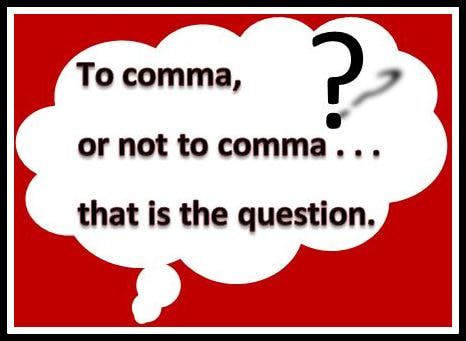
 The comma is the most used and abused form of punctuation. It will either help the reader along with your story or annoy them with too many commas. I'm going to share a few examples of how to use the comma properly, as well as how not to use it.To Separate Parts of a Series - Use the comma to separate words, phrases, or clauses in a series. It is a substitute for a coordinating conjunction. Usually the final element in the series is preceded by and or or to end the series. i.e. John, Fred, Harry, and Frank. It helps prevent confusion because of the not infrequent appearance of and within the members of a series.To Call Attention To Adjectives - When you call attention to each adjective as individually and separately describing the noun, use a comma to separate the adjectives. i.e. a tall, dark, distinguished gentleman. A comma between adjectives has the same effect as the conjunction and. i.e. a tall and ark and distinguished gentleman.To Separate the Clauses of a Compound Sentence Joined by a Coordinating Conjunction - Use the comma to separate the independent clauses of a compound sentence when they are joined by a coordinating conjunction. The comma is placed immediately before the conjunction (and, but, or, not for, yet) to indicate that the conjunction introduces a clause. i.e. She hasn't succeeded in balancing her checkbook, yet she plans to continue writing checks. When the clauses are very short so that most or all of the sentence can be taken in instantaneously by the eye, the comma is not required. i.e. He sent for her and she came.To Separate Interjections and Similar Nonintegrated Sentence Elements - Occasionally, words or phrases in a sentence do not modify specific words, they are not subjects or verbs, they are not objects of prepositions, etc.Use the comma to set off interjections that are included in sentences. i.e. Oh, I thought so. Hey, watch your step!If the interjection occurs within the sentence, it is separated by two commas. i.e. I tried so hard, alas, to do it.Use the comma to set off any other words or phrases that behave as interjections. i.e. Yes, I'll be glad to. John, get the book.Use the comma to set off sentence modifiers. Such as however, moreover, furthermore, therefore, nevertheless, and phrases like on the other hand, in addition to. To make clear they are not intended to modify a single word, separate them from the rest of the sentence by commas. i.e. However, he caught the bus. She tried, moreover, to attain her goal.Use the comma to set off absolute phrases. Absolute phrases are not connected to the remainder of the sentence by relating words such as prepositions or conjunctions. They are therefore set off by commas. i.e. It seemed sensible, the weather being warm, to pack sunscreen.To Set Off a Long Phrase or Clause Preceding the Subject - Since the first element in an English sentence is normally its subject, any phrase or clause of five words or more preceding the subject is concluded with a comma to indicate the subject is about to appear. i.e. During the long winter of 1881, the king suffered an illness. If the phrase is four words or less, the comma is not necessary. i.e. In 1881 the king suffered an illness.To Indicate Interruptions of Normal Word Order - Normally, adjectives precede the nouns they modify, and, normally, subjects are followed by verbs or by modifying phrases or clauses. i.e. The old and respected firm in the city went bankrupt. If you want to emphasize the adjectives old and respected following the noun firm, they will then be set off by commas. i.e. The firm, old and respected, went bankrupt. The single comma should never interrupt the natural flow of a sentence, but intruding elements of any kind should be indicated by being preceded and followed by commas. i.e. The river, it seems likely, will overflow its banks.To Prevent Misreading - This is one of the most commonly misused forms of commas by leading to momentary confusion. i.e. Soon after, the meeting was adjourned. Without the comma, the reader might read after the meeting as a prepositional phrase, and this fragment would have no subject.Misuse of the Comma - Here are a few examples how "not" to use commas:The carpenter insisted, that he knew what he was doing. [The comma after insisted separates the verb from its object.]He drove a hard, sharp, painful, bargain. [The comma after painful separates the adjective painful from the word it modifies.] source: Essentials of English
The comma is the most used and abused form of punctuation. It will either help the reader along with your story or annoy them with too many commas. I'm going to share a few examples of how to use the comma properly, as well as how not to use it.To Separate Parts of a Series - Use the comma to separate words, phrases, or clauses in a series. It is a substitute for a coordinating conjunction. Usually the final element in the series is preceded by and or or to end the series. i.e. John, Fred, Harry, and Frank. It helps prevent confusion because of the not infrequent appearance of and within the members of a series.To Call Attention To Adjectives - When you call attention to each adjective as individually and separately describing the noun, use a comma to separate the adjectives. i.e. a tall, dark, distinguished gentleman. A comma between adjectives has the same effect as the conjunction and. i.e. a tall and ark and distinguished gentleman.To Separate the Clauses of a Compound Sentence Joined by a Coordinating Conjunction - Use the comma to separate the independent clauses of a compound sentence when they are joined by a coordinating conjunction. The comma is placed immediately before the conjunction (and, but, or, not for, yet) to indicate that the conjunction introduces a clause. i.e. She hasn't succeeded in balancing her checkbook, yet she plans to continue writing checks. When the clauses are very short so that most or all of the sentence can be taken in instantaneously by the eye, the comma is not required. i.e. He sent for her and she came.To Separate Interjections and Similar Nonintegrated Sentence Elements - Occasionally, words or phrases in a sentence do not modify specific words, they are not subjects or verbs, they are not objects of prepositions, etc.Use the comma to set off interjections that are included in sentences. i.e. Oh, I thought so. Hey, watch your step!If the interjection occurs within the sentence, it is separated by two commas. i.e. I tried so hard, alas, to do it.Use the comma to set off any other words or phrases that behave as interjections. i.e. Yes, I'll be glad to. John, get the book.Use the comma to set off sentence modifiers. Such as however, moreover, furthermore, therefore, nevertheless, and phrases like on the other hand, in addition to. To make clear they are not intended to modify a single word, separate them from the rest of the sentence by commas. i.e. However, he caught the bus. She tried, moreover, to attain her goal.Use the comma to set off absolute phrases. Absolute phrases are not connected to the remainder of the sentence by relating words such as prepositions or conjunctions. They are therefore set off by commas. i.e. It seemed sensible, the weather being warm, to pack sunscreen.To Set Off a Long Phrase or Clause Preceding the Subject - Since the first element in an English sentence is normally its subject, any phrase or clause of five words or more preceding the subject is concluded with a comma to indicate the subject is about to appear. i.e. During the long winter of 1881, the king suffered an illness. If the phrase is four words or less, the comma is not necessary. i.e. In 1881 the king suffered an illness.To Indicate Interruptions of Normal Word Order - Normally, adjectives precede the nouns they modify, and, normally, subjects are followed by verbs or by modifying phrases or clauses. i.e. The old and respected firm in the city went bankrupt. If you want to emphasize the adjectives old and respected following the noun firm, they will then be set off by commas. i.e. The firm, old and respected, went bankrupt. The single comma should never interrupt the natural flow of a sentence, but intruding elements of any kind should be indicated by being preceded and followed by commas. i.e. The river, it seems likely, will overflow its banks.To Prevent Misreading - This is one of the most commonly misused forms of commas by leading to momentary confusion. i.e. Soon after, the meeting was adjourned. Without the comma, the reader might read after the meeting as a prepositional phrase, and this fragment would have no subject.Misuse of the Comma - Here are a few examples how "not" to use commas:The carpenter insisted, that he knew what he was doing. [The comma after insisted separates the verb from its object.]He drove a hard, sharp, painful, bargain. [The comma after painful separates the adjective painful from the word it modifies.] source: Essentials of English
Published on November 26, 2018 04:00
November 19, 2018
What's Your Point of View?
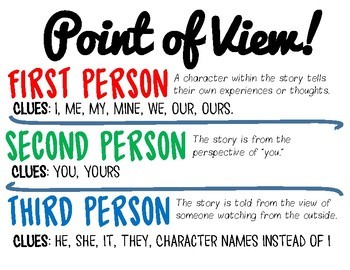 Hello awesome readers and writers! In today's blog post I'm going to talk about your point of view. No, I'm not asking for your opinion, let's face it, we all have one, but I'm going to discuss what your point of view is when it comes to writing.
Hello awesome readers and writers! In today's blog post I'm going to talk about your point of view. No, I'm not asking for your opinion, let's face it, we all have one, but I'm going to discuss what your point of view is when it comes to writing.Now, many writers have an opinion about how many actual points of view there are, but I want to share four basic approaches: first person, second person, third person limited, and third person omniscient. First Person - is the "I" voice, where all the narration is written as if the narrator were speaking directly to the readers - "I knew someone had stolen my wallet, but it would be impossible for me to find the culprit on the crowded subway." The first person point of view has many advantages, the main one being it gives your readers a great deal of intimacy with your viewpoint character. In my chick-lit mystery book, Point and Shoot for Your Life, I wrote in the first person. It was a great rush to be able to put all of the things that were in my protagonist's head onto paper allowing the readers to see everything through her eyes. It made it a little more personal. There are some cons when writing in first person, which is you can't write about anything your character wouldn't know. Your main character needs to be in the exact spot of an immediate scene. Another possible con is your readers will only get to know your main character directly. Everyone else is filtered through their eyes. If you're experienced enough, you can potentially write in the first person but from several different viewpoints—in various scenes from inside the head of different characters.Second Person - The story is told to “you.” This POV is not standard in fiction, but it’s still good to know. However, it is common in nonfiction such as technical writing, advertising, speeches, and song lyrics. You essentially become the character or protagonist, you carry the plot, your fate determines the outcome. It pulls the reader into the action of the story, makes the story personal, and surprises the reader. Such writers who have written in second person are William Faulkner, Nathaniel Hawthorne, and Albert Camus.Third Person Omniscient - A technique of writing in third person, in which the narrator knows the feelings and thoughts of every character in the story. It allows for perspective. The writer brings an entire world of his characters to life, and moves from character to character, allowing different voices to interpret the action taking place. Only the narrator possesses the information. Here's an example from Little Women by Louisa May Alcott: “Margaret, the eldest of the four, was sixteen, and very pretty, being plump and fair, with large eyes, plenty of soft brown hair, a sweet mouth, and white hands, of which she was rather vain. Fifteen-year-old Jo was very tall, thin, and brown, and reminded one of a colt … Elizabeth, or Beth, as everyone called her, was a rosy, smooth-haired, bright-eyed girl of thirteen, with a shy manner, a timid voice, and a peaceful expression, which was seldom disturbed …Third Person Limited - The story is about "he" or "she." Perspective is limited. This is the most common point of view in commercial fiction. The writer/narrator is outside of the story and relating the experiences of a character. The central character is not the narrator. The narrator isn't present in the story at all. An example of this style would be from the Harry Potter series by J.K. Rowling. The secrets unfold through Harry, who like the reader, is new to magic and wizardry. Whatever style of writing you choose, the main key is to be consistent. There's nothing worse for the reader to bounce back and forth from one point of view to another. You'll not only lose clout as a storyteller, but you'll also lose the reader.
Remember...Keep on Writing!
Published on November 19, 2018 04:00
November 12, 2018
Transform Your Own Experience Into an Article
[image error] Today I'm going to help you learn how to draw on what you know to write an article that will catch and hold a reader's and editor's interest. Here are 8 steps to get you started:Look for Ideas - Ideas are everywhere, waiting to be found. Think of career plans, goals, special interests, and jot down what resonates with you. Look around at the people you know in your family, co-workers, good friends. Do any of them have an unusual hobby? Find an article in the newspaper. What is your community's most pressing problems.Test Your Ideas and Choose One - Not all of the ideas you write down will work, some may even be too flimsy because you don't know enough about the subject. The main question to ask yourself is: Do I feel excited about this subject? If the answer is yes, then you're on the right track.Zero in on Your Idea and Choose a Slant - If you choose to write about flowers, that's a broad subject. Try to stick to one small aspect on that topic, i.e. perennials, annuals, etc. Once you have zeroed in on your specific topic, you'll need to find a slant, which turns general information into something special. It makes the focus matter even sharper, which will make it attractive to the reader. It's a fresh way to approach your topic.Shape Your Ideas - You probably have many ideas either on paper or in your head. List your ideas in a chart with headings of: Topic, Slant, and Title. Once you have them down in front of you, decide which one you'd like to write first. As always, you'll need a beginning, middle, and an end. If you're doing an article for a magazine, don't forget to add a sidebar, which can add additional, supplementary information.Add to Your Article Plan - Consider using the human angle. Topics that relate to people on a personal level have a good chance for success. You can use anecdotes, and if you're going to use quotes, make sure it is accurate! Don't put words into their mouths or change the meaning of what they're trying to say.Write a Dynamic Lead - You've all heard of the word, hook. That's exactly what your lead sentence or paragraph needs to do, hook the reader and drawn them into the story. You want to grab their attention. A hook can be a snippet of dialogue, an intriguing description, or a graphic bit of action. You want to be able to engage your reader's curiosity.Write Your First Draft - By having drawn up your article plan, you've already begun a rough first draft. As you know, the first draft is your preliminary account. Let your ideas flow as you write. If you write over the designated word count needed, you can always cut back on it later and eliminate what doesn't fit.Tips for Revising Your Draft:Be sure your facts are accurate. They need to be 100% correct. If you don't take the time to check the facts, the rest of your information may be in question.Write with an open-mind. Let your reader's view their own opinion by avoiding your biased viewpoint.Have a good title. Your title is the first impression of your article, so it's important to make it clever to catch a browser's eye and suggest the article's subject matter. It's more than a label. It gives that professional touch. Whatever you choose to write about, just remember to...Keep on Writing!
source: Long Ridge Writer's Group
source: Long Ridge Writer's Group
Published on November 12, 2018 04:00
November 5, 2018
NaNoWriMo - Can You Do It?
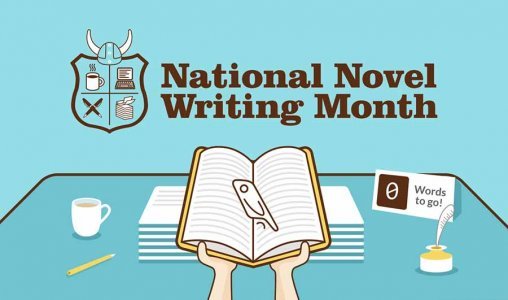 Hello awesome writers and readers! With it being November the obvious topic for this month is, you guessed it, National Novel Writing Month, better known as, NaNoWriMo.
Hello awesome writers and readers! With it being November the obvious topic for this month is, you guessed it, National Novel Writing Month, better known as, NaNoWriMo. Now, a little about NaNoWriMo, if you aren't aware, taken from their website: "National Novel Writing Month (NaNoWriMo) is a fun, seat-of-your-pants approach to creative writing. On November 1, participants begin working towards the goal of writing a 50,000-word novel by 11:59 PM on November 30. Valuing enthusiasm, determination, and a deadline, NaNoWriMo is for anyone who has ever thought about writing a novel."
NaNoWriMo was established in July of 1999 by Chris Baty, and the history of the early beginnings is quite remarkable, and if you're interested in learning about it, you can find it HERE. I'm not going to talk about all of that in this post because I'm one of the writers who have yet to take advantage of this commitment. That's right. I have yet to sign up and commit to writing 1,667 words a day.
My writing career didn't begin until 2007, and I was in the early stages of discovering my muse. It's not that I hadn't heard about NaNoWriMo back in '07. When I first heard about it, I had no clue what it meant and why EVERYONE was signing up. When I learned what the details were, I'll admit it scared me away. I guess it was the fear of me being able to commit to writing that many words each day. I found excuse after excuse and eventually forgot about it year after year. Not to mention that back in the early stages of my writing I worked a full-time job, so I was lucky to write on the weekends. Still...no excuse ;)
It's 2018, and I have yet to take part in NaNoWriMo. I'm not sure if I'm ashamed, embarrassed, or lazy, but after learning more about it and reading the inspirational tips and the different forums, it looks as though this will be a new goal I set for 2019. I almost wished I had signed up this year because I'm in the middle of a story now and there are days when I surpass that 1,667 word count.
So if there is anyone who has taken part in this fantastic endeavor, I'd love to hear your story. Just write in the comment section below. Share any inspiration you have of your own. Why you signed up for NaNoWriMo. Tips you can share, as well as anything else.
I'd also like to hear from those who, like me, haven't signed up yet and your reasons for not doing so, as well as if you have plans to sign up in the future. If you do, don't forget to give them a donation. They're a small non-profit that need to pay for many things to keep this great endeavor going.
Whether you're a NaNoWriMo novice or an expert, as always...Keep On Writing and join NaNoWriMo!
Published on November 05, 2018 04:00
October 25, 2018
9 Steps to Creating a Fictional Story
Choose a Person - Every story needs a central character around whom the actions flows. Choose a real person for your main character and make a sketch plan of this person's traits, age, dress, speech etc. Add details where the person lives, a favorite sport, or lifelong ambition.Fictionalize the Person - Look at your sketch plan for the real person you chose as a character and fictionalize them by changing the color of their hair, change their job, color of their eyes. It's up to you how you alter the real person's features to disguise their identity. Sometimes several people can be combined into one character. Once you have the details of the real-person-turned-character, you've just created your protagonist.Create a Problem - Every story must have a character with a problem to solve. This creates the conflict for your story and makes it exciting and suspenseful. It brings the reader into the story and keeps them wondering what will happen next. The problem doesn't have to be earth shattering. Think of problems that have happened in your life and bring them into the life of your character. The problem can also mean an issue or a demand. Such as, Joe quits his job the same day his wife learns she is pregnant. Using everyday problems will be more likely to help the reader to identify with your story. A good story problem will let your central character use courage, perseverance, and ingenuity to solve the problem.Create a Complication - The harder it is for your character to solve the problem, the more suspense and excitement your story will have. Be sure to add obstacles to carry the story forward. This will intrigue your readers. You want them to worry and care for your character. One way to add an obstacle is to create a character who works against your main character, this would be your antagonist. Someone who gets in the way of your protagonist. They don't necessarily have to be bad, but you want them to want something different than your main character. They both need to seem real to your reader, they both can have good and bad points, nobody is perfect. Good writers show different sides of their characters.Find a Solution - Find out how you want your protagonist to deal with the problem. They need to be actively involved in finding the solution. Make sure you don't rely on luck to solve the problem. It'll disappoint the reader if they follow along with your character's struggle and then the solution appears out of nowhere. A satisfying solution doesn't always have a happy ending. In stories and in real life, problems and conflicts sometimes defy the character's best efforts.Plan Your Story - Build a Framework - Your story needs to have a beginning, middle, and an ending. The beginning of your story introduces the main character and lets the reader know something about the conflict or problem and the setting of the story. The middle of the story is the longest, which is where the important actions takes place, as the protagonist tries to overcome the obstacles to solve the problem. The end of your story is the shortest part. Once the problem is solved (or recognized as insoluble), the reader's interest level drops. As your story evolves, you'll be creating the plot, which is the thread that connects the events of the story, making them into a dynamic whole. The plot is what keeps the reader in suspense.Add to the Story Plan - Where and when will the story take place? What other characters will appear in your story and what roles will they play? What will happen? The setting can be simple and can either be vividly described or mentioned in a passing comment. Your story can take place in the present or past. Adding to your cast of characters is as important as your protagonist and antagonist. You don't need to know all of your characters at the start, they'll tend to come to you as your write your story. Plan your plot and refer to your notes of the details of your setting, characters, etc.Write Your First Draft - Many writers have MANY opinions on how to start writing your story, but one way is to begin just writing one small scene. Include the complications listed in the middle of your story plan. The point of view can either be written in first person - written as if you are the main character, or third person - written as an unseen narrator. Just let your ideas come to life and get it on paper. Once you have the entire story sketched out, you can rearrange things to make sure the story flows.Polish Your Story - Once you've completed your first draft, put it aside and let it cool for a day or so. You'll come back to it with fresh eyes. Ask yourself, is the main character interesting to care about? Does the plot generate enough suspense to keep you reading? Have you introduced the conflict or problem? Does your character use courage and determination to solve the problem. Is the final solution believable?Don't forget you are learning new techniques every step of the way. The more you write, the easier it will be to apply these techniques. Don't agonize over your final draft. Try to remember why you're writing and enjoy bringing all the ideas rolling around in your head and putting them to paper.
Remember...Keep on Writing!
Remember...Keep on Writing!
Published on October 25, 2018 04:00



